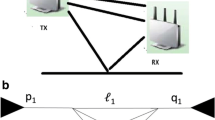Abstract
The range of potential applications for indoor and campus based personnel localisation has led researchers to create a wide spectrum of different algorithmic approaches and systems. However, the majority of the proposed systems overlook the unique radio environment presented by the human body leading to systematic errors and inaccuracies when deployed in this context. In this paper RSSI-based Monte Carlo Localisation was implemented using commercial 868 MHz off the shelf hardware and empirical data was gathered across a relatively large number of scenarios within a single indoor office environment. This data showed that the body shadowing effect caused by the human body introduced path skew into location estimates. It was also shown that, by using two body-worn nodes in concert, the effect of body shadowing can be mitigated by averaging the estimated position of the two nodes worn on either side of the body.









Similar content being viewed by others
References
A. Boukerche, H. Oliveira, E. Nakamura and A. Loureiro, Localization systems for wireless sensor networks. IEEE Wireless Communications, Vol. 14, No. 6, pp. 6–12, 2007.
N. Patwari, J. N. Ash, S. Kyperountas, A. O. Hero, R. L. Moses and N. S. Correal, Locating the nodes: cooperative localization in wireless sensor networks. IEEE Signal Processing Magazine, Vol. 22, No. 4, pp. 54–69, 2005.
N. B. Priyantha, A. Chakraborty, and H. Balakrishnan, The Cricket location-support system. Annual International Conference on Mobile Computing and Networking, pp. 32–43, 2000.
N. Bulusu, J. Heidemann and D. Estrin, GPS-less low-cost outdoor localization for very small devices. IEEE Personal Communications, Vol. 7, No. 5, pp. 28–34, 2000.
L. Doherty, K. S. J. Pister and L. El Ghaoui, Convex position estimation in wireless sensor networks. IEEE International Conference on Computer Communications, Vol. 3, pp. 1655–1663, 2001.
Niculescu, D., and Nath, B. Ad hoc positioning system (APS), Global Telecommunications Conference (GLOBECOM), pp. 2926–2931, 2001.
Y. Shang, and W. Ruml, Improved MDS-based localization. IEEE International Conference on Computer Communications, pp. 2640–2651, 2004.
P. Motter, R.S. Allgayer, I. Muller, C.E. Pereira, and E. Pignaton de Freitas, Practical issues in Wireless Sensor Network localization systems using received signal strength indication. IEEE Sensors Applications Symposium, pp. 227–232, 2011.
C.-H. Chang, and W. Liao, Revisiting relative location estimation in wireless sensor networks. IEEE International Conference on Communications, pp. 1–5, 2009.
P. Bahl, and V. N. Padmanabhan, RADAR: an in-building RF-based user location and tracking system. Proceedings of 19th Annual Joint Conference of the IEEE Computer and Communications Societies, Vol. 2, pp. 775–784, 2000.
L. Hu, and D. Evans, Localization for mobile sensor networks. Proceedings of the 10th annual international conference on Mobile computing and networking, pp. 45–57, 2004.
M.H.T. Martins, H. Chen, and K. Sezaki, OTMCL: Orientation tracking-based Monte Carlo localization for mobile sensor networks. International Conference on Networked Sensing Systems, pp. 1–8, 2009.
M. Rudafshani, and S. Datta, Localization in wireless sensor networks. International Conference on Information Processing in Sensor Networks, pp. 51–60, 2007.
S. Zhang, J. Cao, C. Li-Jun and D. Chen, Accurate and energy-efficient range-free localization for mobile sensor networks. IEEE Transactions on Mobile Computing, Vol. 9, No. 6, pp. 897–910, 2010.
W. D. Wang and Q. X. Zhu, RSS-based Monte Carlo localisation for mobile sensor networks. IET Communications, Vol. 2, No. 5, pp. 673–681, 2008.
W.P.L. Cully, S.L. Cotton, W.G. Scanlon, and J.B. McQuiston, Localization algorithm performance in ultra low power active RFID based patient tracking. 22nd IEEE International Symposium on Personal, Indoor & Mobile Radio Conference (PIMRC), Toronto, Canada, pp. 2303–2307, 2011.
W.P.L. Cully, S.L. Cotton, W.G. Scanlon, and J.B. McQuiston, Body shadowing mitigation using differentiated LOS/NLOS channel models for RSSI-based Monte Carlo personnel localization. IEEE Wireless Communications & Networking Conference (WCNC 2012), Paris, France, 2012.
M. S. Arulampalam, S. Maskell, N. Gordon and T. Clapp, A tutorial on particle filters for online nonlinear/non-Gaussian Bayesian tracking. IEEE Transactions on Signal Processing, Vol. 50, No. 2, pp. 174–188, 2002.
C. Guo, J. Wang, R.V. Prasad, and M. Jacobsson, Improving the accuracy of person localization with body area sensor networks: An experimental study. 2009 6th IEEE Consumer Communications and Networking Conference, pp. 1–5, 2009.
Acknowledgments
This work was supported in part by a research studentship from the Centre for Secure Information Technology, Institute of Electronics, Communications and Information Technology, Queen’s University Belfast. The author’s are grateful to ACT Wireless Limited for supplying equipment and data acquisition software, and are grateful to Dr. Adrian McKernan of ACT Wireless who assisted with the measurements.
Author information
Authors and Affiliations
Corresponding author
Rights and permissions
About this article
Cite this article
Cully, W.P.L., Cotton, S.L. & Scanlon, W.G. Empirical Performance of RSSI-Based Monte Carlo Localisation for Active RFID Patient Tracking Systems. Int J Wireless Inf Networks 19, 173–184 (2012). https://doi.org/10.1007/s10776-012-0189-x
Received:
Accepted:
Published:
Issue Date:
DOI: https://doi.org/10.1007/s10776-012-0189-x




